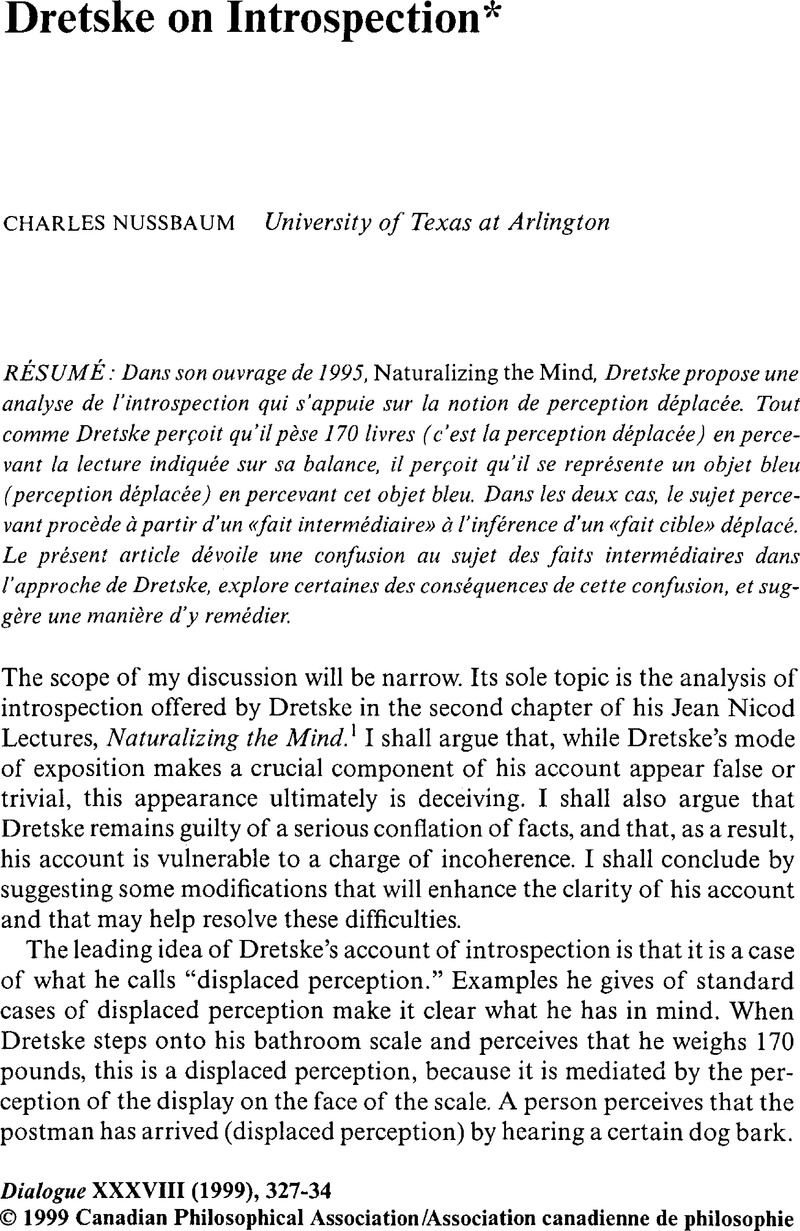No CrossRef data available.
Article contents
Dretske on Introspection*
Published online by Cambridge University Press: 13 April 2010
Abstract

- Type
- Articles
- Information
- Dialogue: Canadian Philosophical Review / Revue canadienne de philosophie , Volume 38 , Issue 2 , Spring 1999 , pp. 327 - 334
- Copyright
- Copyright © Canadian Philosophical Association 1999
References
Notes
1 Dretske, Fred I., Naturalizing the Mind (Cambridge, MA: Bradford/MIT Press, 1995).Google Scholar
2 Dretske calls such a perception a systemic representation, one that has to do with the physical capacities of a representational system, or, in an organism (a natural representational system), its phylogenetically transmitted representational capacities. Systemic representation (sense experience in an organism) is contrasted with acquired (or conceptual) representation, which is, in an organism, developed ontogenetically. In an artificial representational system such as a speedometer, the systemic representations consist of the information present in its mechanism, while the acquired representations are the calibrations on its face. The same speedometer could be differently calibrated (its acquired representations, say, changed from English to metric units) while utilizing the same systemic representations (the information encoded in its mechanism).
3 Dretske applies the intermediate/target distinction both to facts (ibid., p. 61) and to objects (p. 42).
4 In one place (ibid., p. 44) Dretske says “[o]ne comes to know (the fact) that one is experiencing blue by experiencing, not the experience of blue, but some displaced object.” For clarity, what he should say is “some distal object,” since, according to the displaced perception theory, the displaced object is typically the target object and not the intermediate object.
5 The first-person formulation is easier to handle than Dretske's second-person formulation, but does not, I believe, change anything essential.
6 By an anonymous referee for Dialogue.
7 Searle, John, Speech Acts (Cambridge: Cambridge University Press, 1969), p. 65, n. 1.CrossRefGoogle Scholar
8 A representational fact concerns the information-providing function of a representational system: “A representational fact about S [a representational system] is a fact about what S is designed to do, a fact about what information it is supposed to carry” (Dretske, Naturalizing the Mind, p. 3).
9 The same anonymous referee suggests that this version of the connecting belief is not only trivial, but that it also begs the question, since the antecedent of the conditional (“I see k as blue”) presupposes the very introspectional abilities Dretske's account is supposed to explain.
10 See below for a discussion of problems that attend taking k as the intermediate object in cases of illusion.
11 Cf. Churchland, Paul, Scientific Realism and the Plasticity of Mind (Cambridge: Cambridge University Press, 1979), p. 57.CrossRefGoogle Scholar
12 In Churchland's sense of “systemic,” not Dretske's.
13 Some of the contents in this and the preceding paragraph were motivated by discussions with Denny Bradshaw and by comments made by the Dialogue referee.
14 When he refers to this version of the intermediate fact (the fact that need not be veridically represented) on p. 60, Dretske has “fact” in quotation marks; when he refers to it on p. 61 he does not. This contributes to the reader's sense that there is a conflation of facts.
15 Compare what Dretske has to say concerning the access to its own representational states had by an artificial representational system such as a pressure gauge: “For in representing k as, say, 14 psi, S automatically—and necessarily—has absolutely reliable information about what the pressure in k would be if S was working right” (Naturalizing the Mind, p. 52). Pressure gauges do not have introspectional capacities because they lack the requisite concepts and the requisite connecting beliefs. But the “privileged information” (ibid., p. 56) that would make introspection possible if they had these concepts and beliefs is there in such instruments, just as it is present in natural representational systems like us that do have introspectional capacities.
16 Dretske distinguishes (ibid., p. 26) between representational facts (see note 8 above) and facts about representations. What object a representation refers to is a fact about that representation (or representational token), not a representational fact. Reference is fixed by a causal relation (C) between an object in the world and the perceiver, but this referential relation is not part of the content of any representation: “S has the function of indicating the F [some property or other] of those objects which stand in C [the causal referential relation] to it, but it does not have the job of indicating—does not therefore represent—which objects—or even whether there is an object—that stands in C to it.” From this, it is clear that, in order for k to serve as the intermediate object for the displaced introspectional awareness of a representation as the target object, it must be a fact about the representational token in question (though not a representational fact) that it refers (or that another token of the same type did on some occasion refer) to k.




